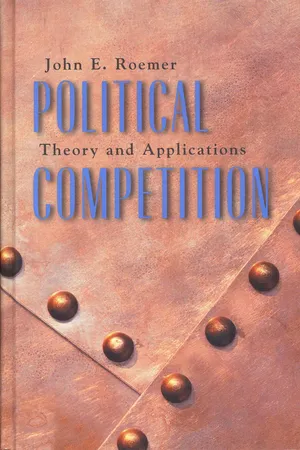
- English
- PDF
- Available on iOS & Android
About this book
In this book, John Roemer presents a unified and rigorous theory of political competition between parties. He models the theory under many specifications, including whether parties are policy oriented or oriented toward winning, whether they are certain or uncertain about voter preferences, and whether the policy space is uni- or multidimensional. He examines all eight possible combinations of these choice assumptions, and characterizes their equilibria.
He fleshes out a model in which each party is composed of three different factions concerned with winning, with policy, and with publicity. Parties compete with one another. When internal bargaining is combined with external competition, a natural equilibrium emerges, which Roemer calls party-unanimity Nash equilibrium.
Assuming only the distribution of voter preferences and the endowments of the population, he deduces the nature of the parties that will form. He then applies the theory to several empirical puzzles, including income distribution, patterns of electoral success, and why there is no labor party in the United States.
Frequently asked questions
- Essential is ideal for learners and professionals who enjoy exploring a wide range of subjects. Access the Essential Library with 800,000+ trusted titles and best-sellers across business, personal growth, and the humanities. Includes unlimited reading time and Standard Read Aloud voice.
- Complete: Perfect for advanced learners and researchers needing full, unrestricted access. Unlock 1.4M+ books across hundreds of subjects, including academic and specialized titles. The Complete Plan also includes advanced features like Premium Read Aloud and Research Assistant.
Please note we cannot support devices running on iOS 13 and Android 7 or earlier. Learn more about using the app.
Information
Table of contents
- Contents
- Preface
- Introduction
- 1. Political Competition over a Single Issue: The Case of Certainty
- 2. Modeling Party Uncertainty
- 3. Unidimensional Policy Spaces with Uncertainty
- 4. Applications of the Wittman Model
- 5. Endogenous Parties: The Unidimensional Case
- 6. Political Competition over Several Issues: The Case of Certainty
- 7. Multidimensional Issue Spaces and Uncertainty: The Downs Model
- 8. Party Factions and Nash Equilibrium
- 9. The Democratic Political Economy of Progressive Taxation
- 10. Why the Poor Do Not Expropriate the Rich in Democracies
- 11. Distributive Class Politics and the Political Geography of Interwar Europe
- 12. A Three-Class Model of American Politics
- 13. Endogenous Parties with Multidimensional Competition
- 14. Toward a Model of Coalition Government
- Mathematical Appendix
- References
- Index